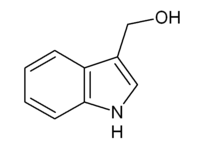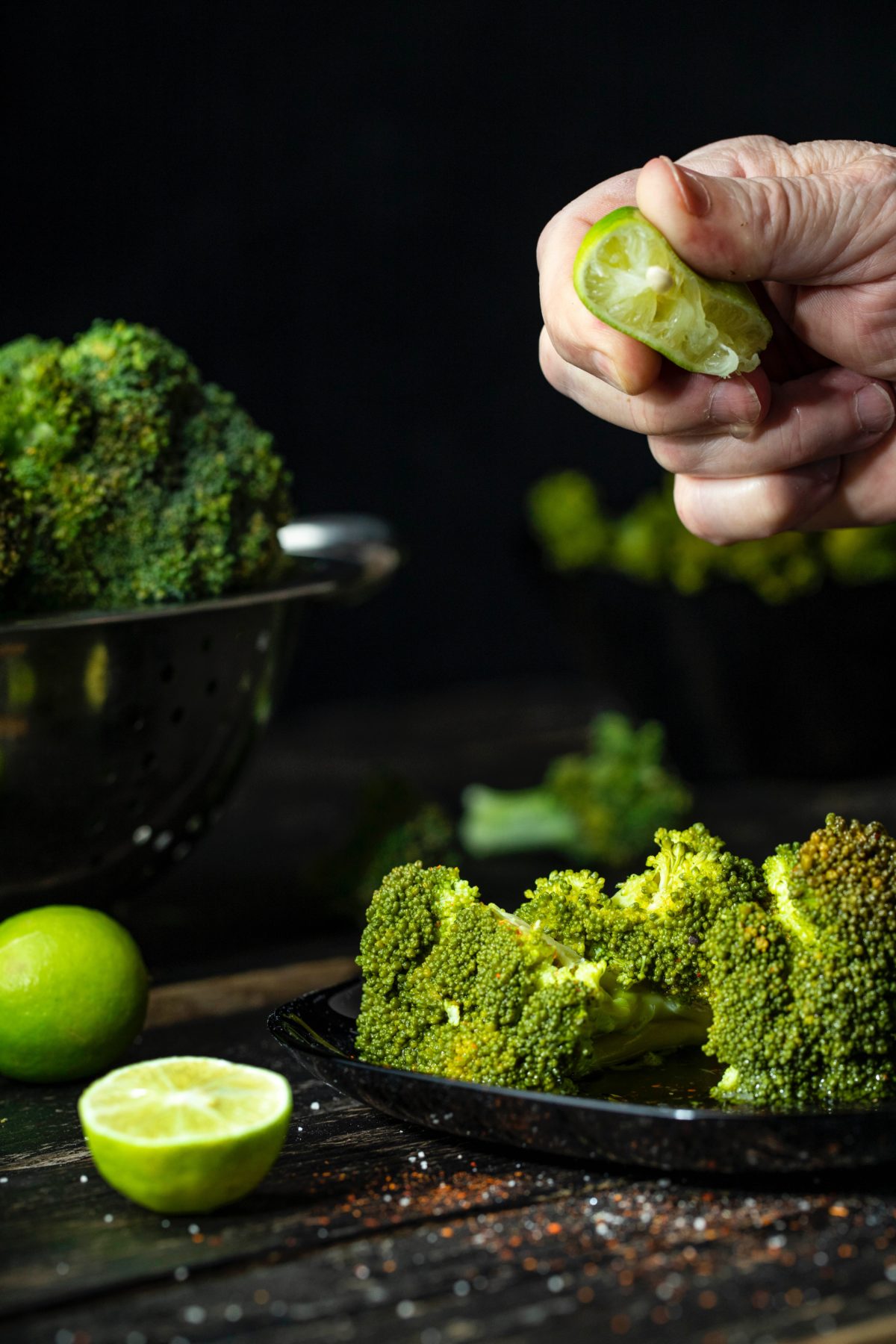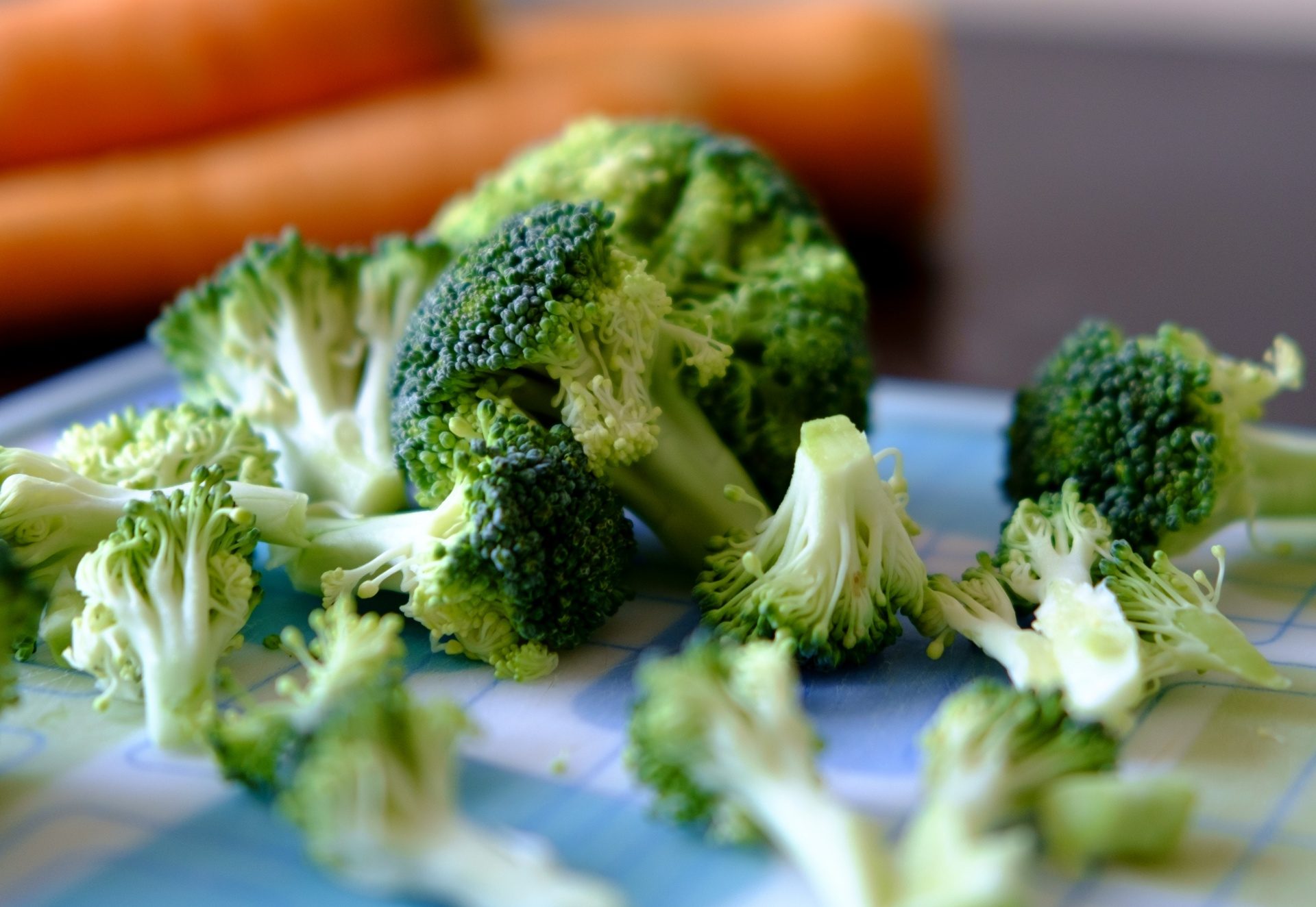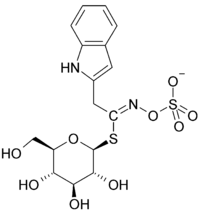Τι είναι το μπρόκολο;
Το μπρόκολο, το γνωστό λαχανικό, ακούγεται συχνά ότι έχει ενδεχόμενες αντιοιστρογονικές ιδιότητες. Ισχύει άραγε κάτι τέτοιο; Ας εξετάσουμε αναλυτικά τη βιβλιογραφία.
Το μπρόκολο ανήκει στα λεγόμενα σταυρανθή (cruciferae) τα οποία είναι η οικογένεια των φυτών που αποτελούνται από το λάχανο, το κουνουπίδι, το μπρόκολο, το ραπανάκι, κτλ, και ο λόγος για την ονομασία “σταυρανθή” είναι το σχήμα σταυρού που φέρουν τα άνθη τους. Η επίσημη ονομασία της οικογένειάς τους είναι “Brassicaceae”, και μία από τις πολλές χημικές ενώσεις που περιέχουν ονομάζεται γλυκοβρασικίνη (glucobrassicin):
Το πάνω τμήμα του μορίου όταν διασπαστεί από το υπόλοιπο μόριο, δίνει την ινδολο-3-καρβινόλη, ουσία για την οποία γίνεται ο μεγάλος ντόρος:

Πώς σχετίζεται το μπρόκολο με τον ανθρώπινο μεταβολισμό;
Μελέτες έχουν επιβεβαιώσει ότι η ινδολο-3-καρβινόλη επεμβαίνει στον ανθρώπινο μεταβολισμό, και ειδικότερα στον μεταβολισμό των οιστρογόνων. Μη βιαστείτε, οι μελέτες δεν έγιναν για όσους κάνουν bodybuilding, αλλά αφορούσαν την ικανότητα της ινδολο-3-καρβινόλης να μειώνει τη συχνότητα των καρκινικών όγκων, και αυτό το πετύχαινε επειδή ακριβώς επηρεάζει τα οιστρογόνα.
Λόγω των μελετών αυτών, όλη η οικογένεια που περιέχει το λάχανο, το μπρόκολο, και σία, θεωρείται αντικαρκινική. Η ινδολο-3-καρβινόλη πωλείται επίσης και ως συμπλήρωμα ή ως συστατικό συμπληρωμάτων που υποτίθεται ότι ανεβάζουν την τεστοστερόνη με φυσικό τρόπο.
Αυτό που είναι επιβεβαιωμένο από μελέτες είναι η αντικαρκινική δράση στον καρκίνο του μαστού. Επίσης υπάρχουν σημαντικές ενδείξεις για αντικαρκινική δράση και στον καρκίνο του προστάτη. Ο τρόπος με τον οποίο επιτυγχάνεται αυτό είναι η ρύθμιση της αναλογίας μεταξύ δύο μεταβολιτών στο μεταβολισμό των οιστρογόνων (η αναλογία αυτή έχει συνδεθεί με την πιθανότητα εμφάνισης καρκίνου στο μαστό).
Αυξάνει άραγε την τεστοστερόνη το μπρόκολο; Αν το μπρόκολο μπορεί να μπλοκάρει σε κάποιο βαθμό την αρωματάση, δηλαδή το ένζυμο το οποίο “καταστρέφει” τα ανδρογόνα και τα κάνει οιστρογόνα, τότε ίσως θα αυξάνει την ποσότητα της τεστοστερόνης.

Οι έρευνες που μελετούν την επίδραση του μπρόκολου στην τεστοστερόνη
Σε μια μελέτη όπου χρησιμοποιήθηκε αρωματάση από πέστροφα (διαφέρει βέβαια από την αρωματάση του ανθρώπου, αλλά όχι τραγικά), δεν βρέθηκε καμία επίδραση της ινδολο-3-καρβινόλης:
1: J Steroid Biochem Mol Biol. 1999 Jul-Aug;70(1-3):89-95.
Rainbow trout, Oncorhynchus mykiss, as a model for aromatase inhibition.
Shilling AD, Carlson DB, Williams DE.
Department of Environmental and Molecular Toxicology and Marine/Freshwater Biomedical Sciences Center, Oregon State University, Corvallis, 97331-6601, USA.
The feasibility of utilizing rainbow trout, Oncorhynchus mykiss, as an alternative model for studying the inhibition of aromatase (CYP 19) was investigated. The suppression of estrogen-dependent tumors by aromatase inhibitors has been important in the treatment of breast cancer. Estrogens, estrogen precursors and xenoestrogens have been found to promote liver cancer in the trout model. A steroid, 4-hydroxy-4-androstene-3,17-dione (4-OHA), and non-steroids, aminoglutethimide (AG) and Letrozole (CGS 20267), all of which are known aromatase inhibitors in rats and humans, were examined in vitro for activity in trout ovarian microsomes. Aromatase activity was quantified as the release of 3H2O from the conversion of [3H]-4-androstene-3,17-dione to 17beta-estradiol and estrone. Trout ovarian microsomes exhibited activity between 39-60 fmol mg(-1) min(-1) with a calculated Vmax of 71.1 fmol mg(-1) min(-1) when incubated at 25 degrees C with 200 nM 4-androstene-3,17-dione (K(M) = 435 nM). Significant inhibition by 4-OHA up to 80% was seen at 1.5 microM. At 2000 microM, AG decreased aromatase activity by up to 82%. Letrozole reduced aromatase activity a maximum of 90% in a dose-dependent manner, but the Ki (2.3 microM) was 1000-fold higher than reported in human trials. Indole-3-carbinol and some of its derivatives, two DDE isomers and four flavones (except alpha-naphthoflavone) at 1000 microM did not significantly inhibit aromatase in vitro. Letrozole and clotrimazole, fed to juvenile rainbow trout at doses up to 1000 ppm for 2 weeks, were not effective in suppressing dehydroepiandrosterone (DHEA) induced increases in vitellogenin and 17beta-estradiol levels. These results document that trout aromatase is sensitive to inhibition in vitro by known inhibitors of the mammalian enzyme. The mechanism(s) for lack of inhibition in vivo is currently unknown and must be further investigated in order to develop a trout model for studying the role of aromatase in carcinogenesis.
Ένα συμπλήρωμα που περιείχε διάφορα προορμονικά και testosterone-boosters (μαζί με ινδολο-3-καρβινόλη) σε ασκούμενους με βάρη, δεν επηρέασε την ολική τεστοστερόνη, ούτε τη μυϊκή δύναμη, ούτε ελάττωσε την οιστρογονική επίδραση της ανδροστενεδιόνης.
1: Int J Sport Nutr Exerc Metab. 2000 Sep;10(3):340-59.
Effects of anabolic precursors on serum testosterone concentrations and adaptations to resistance training in young men.
Brown GA, Vukovich MD, Reifenrath TA, Uhl NL, Parsons KA, Sharp RL, King DS.
Exercise Biochemistry Laboratory, Department of Health and Human Performance, Iowa State University, Ames, IA 50011, USA.
The effects of androgen precursors, combined with herbal extracts designed to enhance testosterone formation and reduce conversion of androgens to estrogens was studied in young men. Subjects performed 3 days of resistance training per week for 8 weeks. Each day during Weeks 1, 2, 4, 5, 7, and 8, subjects consumed either placebo (PL; n = 10) or a supplement (ANDRO-6; n = 10), which contained daily doses of 300 mg androstenedione, 150 mg DHEA, 750 mg Tribulus terrestris, 625 mg Chrysin, 300 mg Indole-3-carbinol, and 540 mg Saw palmetto. Serum androstenedione concentrations were higher in ANDRO-6 after 2, 5, and 8 weeks (p <.05), while serum concentrations of free and total testosterone were unchanged in both groups. Serum estradiol was elevated at Weeks 2, 5, and 8 in ANDRO-6 (p <.05), and serum estrone was elevated at Weeks 5 and 8 (p <.05). Muscle strength increased (p <.05) similarly from Weeks 0 to 4, and again from Weeks 4 to 8 in both treatment groups. The acute effect of one third of the daily dose of ANDRO-6 and PL was studied in 10 men (23 +/- 4 years). Serum androstenedione concentrations were elevated (p <.05) in ANDRO-6 from 150 to 360 min after ingestion, while serum free or total testosterone concentrations were unchanged. These data provide evidence that the addition of these herbal extracts to androstenedione does not result in increased serum testosterone concentrations, reduce the estrogenic effect of androstenedione, and does not augment the adaptations to resistance training.
Το ίδιο πράγμα ξαναμετρήθηκε ένα χρόνο αργότερα από τους ίδιους ερευνητές, σε μη ασκούμενους, και με ίδια αποτελέσματα, εκτός από το ότι η ελεύθερη τεστοστερόνη είχε αυξηθεί κατά 28% (η συνολική όμως παρέμεινε ίδια):
1: Int J Vitam Nutr Res. 2001 Sep;71(5):293-301.
Effects of androstenedione-herbal supplementation on serum sex hormone concentrations in 30- to 59-year-old men.
Brown GA, Vukovich MD, Martini ER, Kohut ML, Franke WD, Jackson DA, King DS.
Exercise Biochemistry Laboratory, Department of Health and Human Performance, Iowa State University, Ames, IA, USA.
The effectiveness of a nutritional supplement designed to enhance serum testosterone concentrations and prevent the formation of dihydrotestosterone and estrogens from the ingested androgens was investigated in healthy 30- to 59-year old men. Subjects were randomly assigned to consume DION (300 mg androstenedione, 150 mg dehydroepiandrosterone, 540 mg saw palmetto, 300 mg indole-3-carbinol, 625 mg chrysin, and 750 mg Tribulus terrestris per day; n = 28) or placebo (n = 27) for 28 days. Serum free testosterone, total testosterone, androstenedione, dihydrotestosterone, estradiol, prostate-specific antigen (PSA), and lipid concentrations were measured before and throughout the 4-week supplementation period. Serum concentrations of total testosterone and PSA were unchanged by supplementation. DION increased (p < 0.05) serum androstenedione (342%), free testosterone (38%), dihydrotestosterone (71%), and estradiol (103%) concentrations. Serum HDL-C concentrations were reduced by 5.0 mg/dL in DION (p < 0.05). Increases in serum free testosterone (r2 = 0.01), androstenedione (r2 = 0.01), dihydrotestosterone (r2 = 0.03), or estradiol (r2 = 0.07) concentrations in DION were not related to age. While the ingestion of androstenedione combined with herbal products increased serum free testosterone concentrations in older men, these herbal products did not prevent the conversion of ingested androstenedione to estradiol and dihydrotestosterone.
Σε μια άλλη ενδιαφέρουσα μελέτη (υπάρχουν και άλλες με παρόμοια συμπεράσματα), ο ισοθειοκυανικός φαιναιθυλεστέρας (phenethyl isothiocyanate) που περιέχει το μπρόκολο, το λάχανο, κτλ, μείωσε τα ανδρογονικά side-effects (μεγάλωμα προστάτη) που προκαλούσε η χρήση τεστοστερόνης σε ποντίκια:
1: Prostate. 2007 Jun 1;67(8):863-70.
Modulating testosterone stimulated prostate growth by phenethyl isothiocyanate via Sp1 and androgen receptor down-regulation.
Beklemisheva AA, Feng J, Yeh YA, Wang LG, Chiao JW.
Department of Medicine, New York Medical College, Valhalla, New York 10595, USA.
BACKGROUND: The effects of phenethyl isothiocyanate (PEITC), present naturally in cruciferous vegetables, on androgen-influenced growth of the prostate such as benign hyperplasia, was investigated. METHODS: Rats dosed with cyproterone acetate and testosterone, were fed at the same time with either PEITC or vehicle control. The growth of the prostates was compared to untreated rats. RESULTS: While testosterone increased the prostate mass (30%) and hyperplastic seminiferous tubules as compared to the untreated rats, PEITC feeding decreased the prostate mass and hyperplasia to roughly the levels of untreated rats (P < 0.05). PEITC negated the testosterone-mediated enhancement of the androgen receptor (AR), via down-regulating transcription factor Sp1 expression and Sp1 binding complex formation. Cell cycle progression was attenuated with decreases of cyclins, Rb, and up-regulates p27. CONCLUSIONS: PEITC modulates the testosterone-influenced growth by repressing Sp1, thus down-regulating AR and proliferation. PEITC from cruciferous vegetables may represent a regulator for hormone-dependent growth of the prostate. Copyright 2007 Wiley-Liss, Inc.
Συμπεράσματα
Ποιο είναι το συμπέρασμα; Το μπρόκολο, καθώς και το λάχανο, το κουνουπίδι, και το ραπανάκι είναι λαχανικά με πολλές χημικές ουσίες με διαπιστωμένες αντιοξειδωτικές και αντικαρκινικές ιδιότητες, τουλάχιστον στο θέμα του καρκίνου του μαστού – και ίσως και του προστάτη. Δεν δείχνουν να έχουν σημαντικές αντιοιστρογονικές ιδιότητες, αλλά ρυθμίζουν αποτελεσματικά τον μεταβολισμό των οιστρογόνων, προστατεύοντας τον οργανισμό από τη δημιουργία καρκίνων και συνεισφέροντας γενικά στην καλή υγεία. Δεν φαίνονται να αυξάνουν την τεστοστερόνη, όμως ενδέχεται να απαλύνουν τα ανδρογονικά sife-effects, πράγμα θα μπορούσε ίσως να έχει μια κάποια (περιορισμένη;) χρησιμότητα σε όσους χρησιμοποιούν ΑΑΣ.




